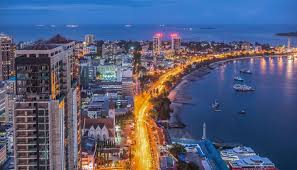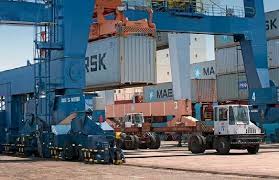Comparative Analysis of KPA and Dar es Salaam Port’s Performance on Market Dynamics in 2024–2025

Dar es Salaam Port managed by the Tanzania Ports Authority. (Photo/ Courtesy)
By Andrew Mwangura
Email, thecoastnewspaper@gmail.com
The Kenya Ports Authority (KPA), through its flagship Port of Mombasa, has long been a cornerstone of East Africa’s maritime logistics, serving as the primary gateway for Kenya and landlocked neighbors like Uganda.
Its strategic success in retaining Uganda as a leading transit market customer, commanding 65.75 percent of the market share in 2024 and achieving an 85.7 percent Customer Satisfaction Index in 2023, underscores its operational excellence and customer-centric approach.
However, the Port of Dar es Salaam, managed by the Tanzania Ports Authority (TPA), has emerged as a formidable competitor, challenging Mombasa’s regional dominance.
This editorial compares the performance, market dynamics, and strategic initiatives of these two critical East African ports in 2024 and 2025, drawing on available data and regional trade trends.
Performance Metrics and Efficiency
In 2024, the Port of Mombasa recorded significant growth, handling 35.98 million tons of cargo in 2023, a rise from 33.88 million tons in 2022, with container throughput reaching 1.6 million TEUs, up from 1.45 million.
KPA reported an 8.1 percent cargo volume increase in the first half of 2025, reaching 21.3 million tons, driven by improved infrastructure and faster cargo handling despite Red Sea disruptions.
KPA forecasts container handling to hit 1.8 million TEUs in 2024, with ambitions to reach 2 million TEUs by year-end.
These figures reflect Mombasa’s robust capacity, bolstered by investments in 16 ship-to-shore gantries, new cranes, and the expansion of Berth 19B.
In contrast, Dar es Salaam Port also showcased impressive performance, handling 26.6 million tons of cargo in the 2024 fiscal year, a 16.2 percent jump from the previous year.
While specific 2024 TEU figures for Dar es Salaam are unavailable, its strategic importance is evident, handling over 70 percent of Rwanda’s imports, valued at $650 million in 2024.
However, Dar es Salaam faces challenges like congestion and inefficiencies, which have kept it from ranking among Africa’s top 10 ports in the World Bank’s 2023 Container Port Performance Index (CPPI).
In the CPPI, Mombasa ranked 328 globally, surpassing Dar es Salaam, which dropped to 367 from 312 in 2022, indicating Mombasa’s edge in efficiency metrics like vessel turnaround time.
A 2024 study using a hybrid DEA-CVA model found that both ports have unique strengths: Mombasa excels in ship calls due to its advanced equipment, while Dar es Salaam leverages its shorter Central Corridor (1,300 km vs. Mombasa’s 1,700 km Northern Corridor) to serve landlocked markets like Rwanda and Burundi.
However, Dar es Salaam’s efficiency is hampered by administrative bottlenecks, while Mombasa struggles with high logistics costs along the Northern Corridor.

Market Share and Regional Competition
Mombasa’s dominance in the transit market, particularly with Uganda (62.3 percent of transit cargo), South Sudan (52 percent), and the DRC (57 percent), is a strategic triumph.
KPA’s Kampala Liaison Office, operational since 1996, has fostered close ties with Ugandan stakeholders, reflected in the 85.7 percent satisfaction score.
Yet, Dar es Salaam has made significant inroads, capturing over 70 percent of Rwanda’s imports and increasing its share of Uganda, Burundi, and DRC cargo.
Posts on X and reports from 2023–2025 highlight Dar es Salaam’s growing appeal due to its cost-effectiveness and the Central Corridor’s logistical advantages, including the ongoing Central Corridor Electric Standard Gauge Railway (CCE-SGR) project, set to enhance connectivity by 2025.
Mombasa’s market share has faced pressure, with a reported 4 percent drop in Uganda-bound cargo and a 30 percent decline in Rwanda-bound goods between 2021 and 2022.
To counter this, KPA extended free storage periods in 2023 (from 9 to 15 days, and 30 days for Naivasha ICD) to compete with Dar es Salaam’s lower costs.
Dar es Salaam’s expansion, including new berths and dredging to accommodate larger vessels, positions it to attract more customers, particularly from the DRC, Malawi, and Zambia, as noted in a 2022 GBS Africa report.
Strategic Initiatives and Infrastructure
KPA’s proactive investments align with its Corporate Strategic Plan, including a $31.5 million procurement of gantry cranes in 2024, the upgrading of the Terminal Operating System, and the construction of Berth 19B (300,000 TEU capacity).
The Dongo Kundu Special Economic Zone and collaboration with Japan’s JICA for Berth 23 (500,000 TEU capacity) signal long-term ambition.
KPA’s focus on regional partnerships, as seen in its Uganda outreach, strengthens investor confidence.
Dar es Salaam, under TPA, is also modernizing, with plans for new berths, automated cargo systems, and real-time tracking to address congestion.
The TPA’s Kigali Liaison Office, established in 2024, mirrors KPA’s Kampala model, enhancing coordination with Rwandan importers. The CCE-SGR and a $3 billion dam project to power the corridor underscore Tanzania’s infrastructure push.
However, Dar es Salaam’s operational challenges, such as inefficient cargo handling, require sustained reform to match Mombasa’s efficiency gains.
Critical Analysis and Future Outlook
Mombasa’s edge lies in its advanced infrastructure and customer satisfaction, particularly in Uganda, but high logistics costs and competition threaten its market share.
Dar es Salaam’s cost advantages and shorter corridor appeal to price-sensitive markets like Rwanda, yet its efficiency lags. Both ports must address systemic issues:
Mombasa needs to streamline Northern Corridor logistics, while Dar es Salaam must tackle congestion and bureaucratic delays.
As a policy analyst specialising in maritime governance and blue economy development, I argue that Mombasa’s strategic focus on infrastructure and partnerships positions it slightly ahead in 2024–2025.
However, Dar es Salaam’s aggressive expansion and regional connectivity projects could shift the balance by 2026 if Mombasa does not address cost competitiveness. Both ports should leverage digital technologies—blockchain for transparency, AI for logistics—to enhance efficiency.
Regional cooperation, perhaps through the East African Community, could harmonize standards and reduce trade barriers, benefiting both.

In conclusion, while KPA’s Mombasa Port leads in efficiency and customer trust, Dar es Salaam’s rapid growth and strategic investments make it a serious contender.
The competition is healthy, pushing both to innovate, but sustained reforms and collaboration will determine East Africa’s maritime future.






